Dunstone
Butland Wood
Flete
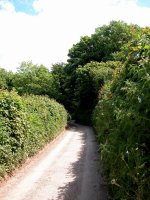
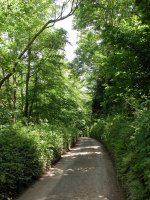 Flete Wood
Flete Wood
The lane onward from the crossroads is narrower and
quieter, and it leads through Flete Wood. The lane, like some we
followed yesterday, is fairly typical of back roads in this part of
Devon. It runs fairly straight, but very narrowly, through tree cover
and high banks.
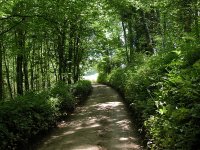

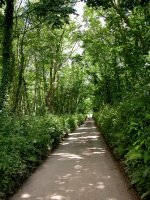 Road through Flete Wood
Road through Flete Wood
At the next junction the main road curves away to the
right. We go to the left here, and almost immediately the lane forks
into two - take the left fork. It's difficult to describe but obvious
enough from the map. Your new lane, even narrower now, runs downhill
and comes to an area with open pastures on the left and woodland on the
right.
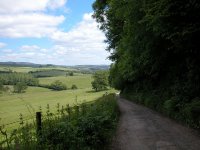

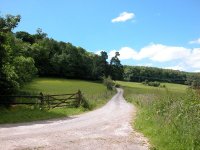
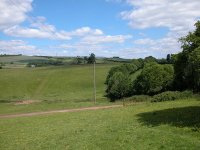
 The route at Flete
The route at Flete
This area appears to be part of the estate of a
country mansion called Flete, about half a mile to the east. The lane
runs downhill to a nameless group of cottages. At the point where you
cross a substantial track (first image above) the map is a little
ambiguous; it suggests that you should continue straight on alongside
the wood, but the correct route doglegs slightly, right then left, into
a little tunnel of woodland (second picture above). The next few
hundred metres is very similar to the route out of Yealmpton this
morning, partly alongside pastures and partly through ribbons of
woodland. After crossing a small brook the route runs slightly uphill
and then becomes confined between hedges.
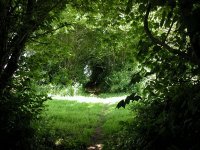 Route through copse
Route through copse
Sequer's Bridge
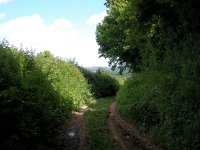

 The Earme-Plym Trail between Flete and Hollowcombe Cross
The Earme-Plym Trail between Flete and Hollowcombe Cross
The lane, still bound by hedges, tends downhill
again. It comes into the open quite suddenly, at which point you cross
a pasture on the diagonal (second picture above) to come out onto the
main road near Hollowcombe Cross. The road is busy, a bit of a culture
shock after today's back lanes, but fortunately a parallel right of way
has been provided alongside the field edges on the north side of the
road; cross a stile (third image above) for access.
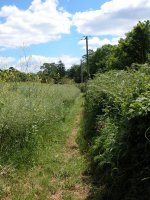
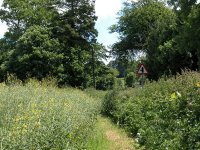
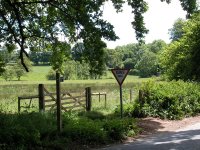 Field-edge paths to Sequers Bridge
Field-edge paths to Sequers Bridge
The sequence of field paths runs eastwards alongside
the road for about half a kilometre, crossing a lane, to reach the
river Earme at Sequers Bridge.
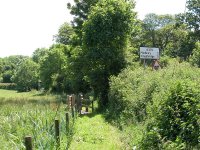

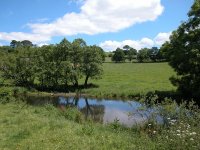 Sequers Bridge
Sequers Bridge
Another bit of potential confusion here. The map
shows two possible routes for the Earme-Plym Trail north of Sequers
Bridge, one each side of the Earme. The waymarks, however, are quite
firm - the correct route is along the east bank. Cross the bridge and
take the stile and steps off to the left, then walk diagonally across
the pasture towards Sexton farm.
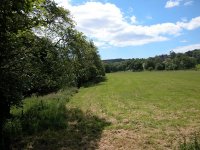
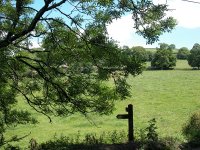
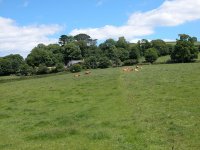
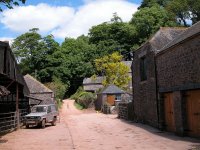
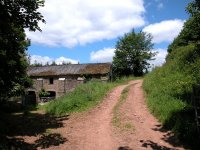 The trail from Sequers Bridge to Sexton farm
The trail from Sequers Bridge to Sexton farm
Sexton turns out to be quite a large cluster of
cottages and barns. Follow the track through the middle and then follow
the waymarks.
Ermington
Strode
Thornham
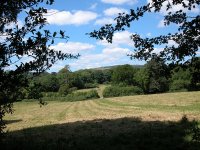
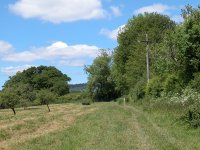
 The route across pastures at Thornham
The route across pastures at Thornham
These pastures appear to be part of the grounds of
Thornham farm, which lays across the river. Frankly, the waymarks could
be a lot better here. Having arrived in the second pasture from the
road, cross it in a west-northwest direction (first picture above).
Head initially for the corner of another field that juts into ours from
the northwest - all the field boundaries hereabouts are formed of
hedges and trees so the field shapes as shown on the map are not
terribly obvious on the ground. There's a small barn just proud of this
field corner to the right, half hidden among trees; leave this well to
your right and start along the field boundary to the west, but at a
power line pole (second image above) turn right into the next pasture.
Cross this on the diagonal to reach a gate into yet another pasture
(third image above).
I lost count of the pastures here and thought I was one gate behind, an
easy mistake to make when you've already got lost twice in the last few
hundred metres. A prominent path runs diagonally across the next
pasture in the same direction we've just come from but this is not the
correct route; instead, stick to the right-hand field boundary and
follow it on its left side. About fifty metres in you will pass a
footpath marker, which would have been more usefully sited back at the
gate.
After some 200 metres the pasture widens and the field boundary you've
been following veers off to the right; ignore it now, keeping straight
ahead. Make for the far northeast corner of the field. Go onwards into
the next field and follow the edge of it all the way to the far end,
where you come out onto another road.
Keaton
Yeolands
The route is never in doubt here, a blessing after
all that intricate and confusing stuff back at Thornham. You're
following a line of power line poles and will probably find cattle
grazing in the field. At the far corner the route enters a short green
lane (pictured below) which in turn comes out into a small residential
road. This is the village of Yeolands.
Things couldn't be simpler from here on. Continue
along the riverbank, theading its way
between Ivybridge's residential roads. In just a quarter of a mile you
will reach a little riverside park, and a footbridge over the river
from here gives access to a smart little glassed-in shopping arcade, at
the other end of which is Ivybridge High St and the end of the day's
walk.

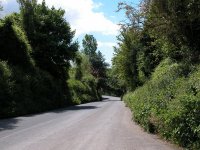
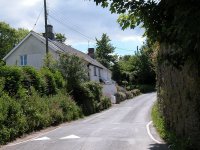
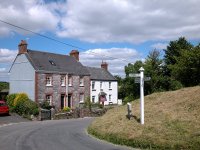

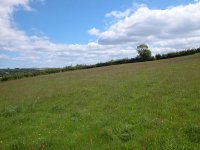
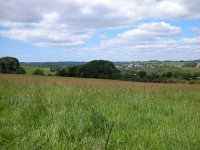

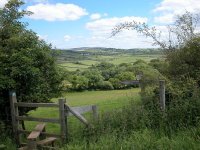
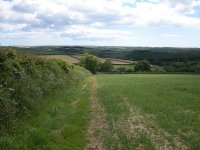

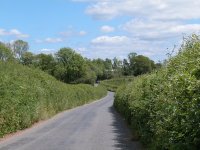

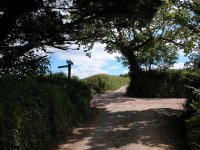

























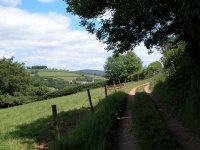
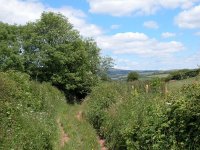
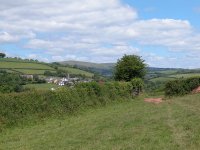
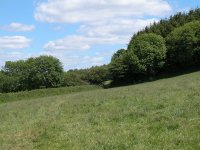
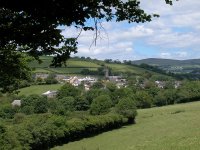
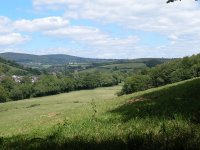

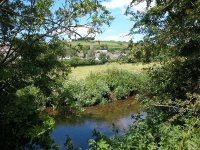
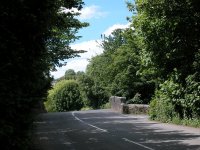
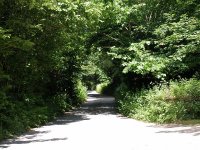
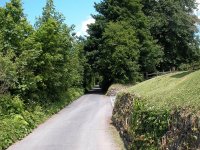
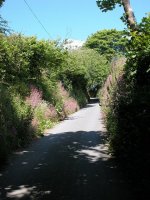





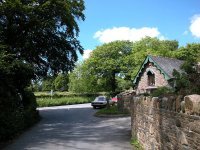
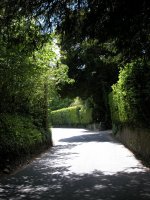
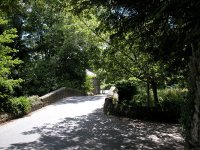
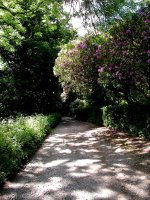
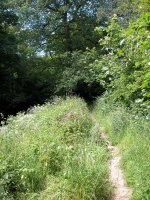
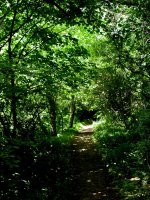
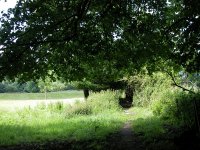
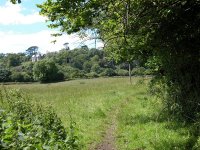
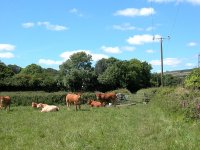
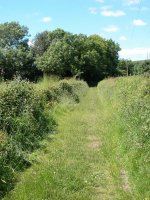


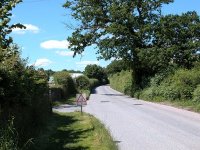
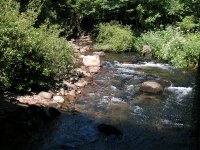
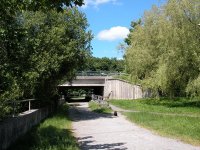

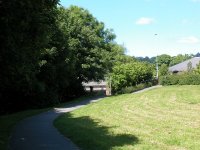
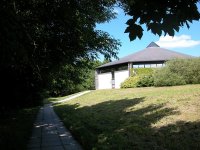
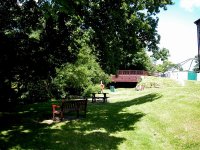
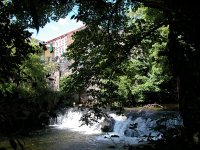
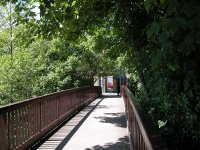
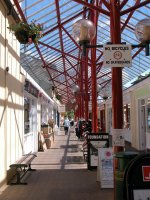


![]()